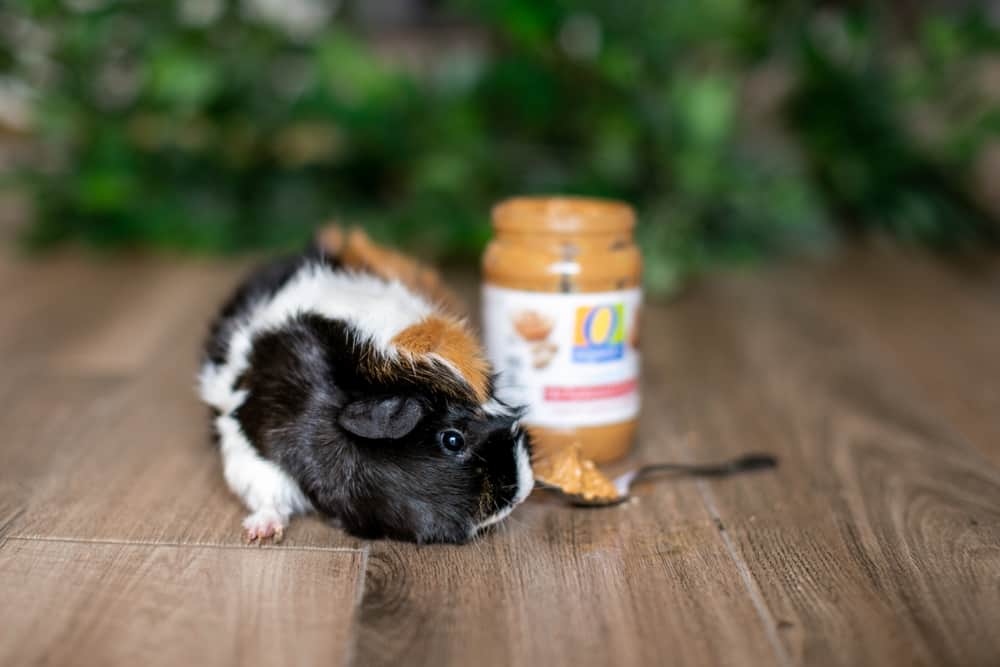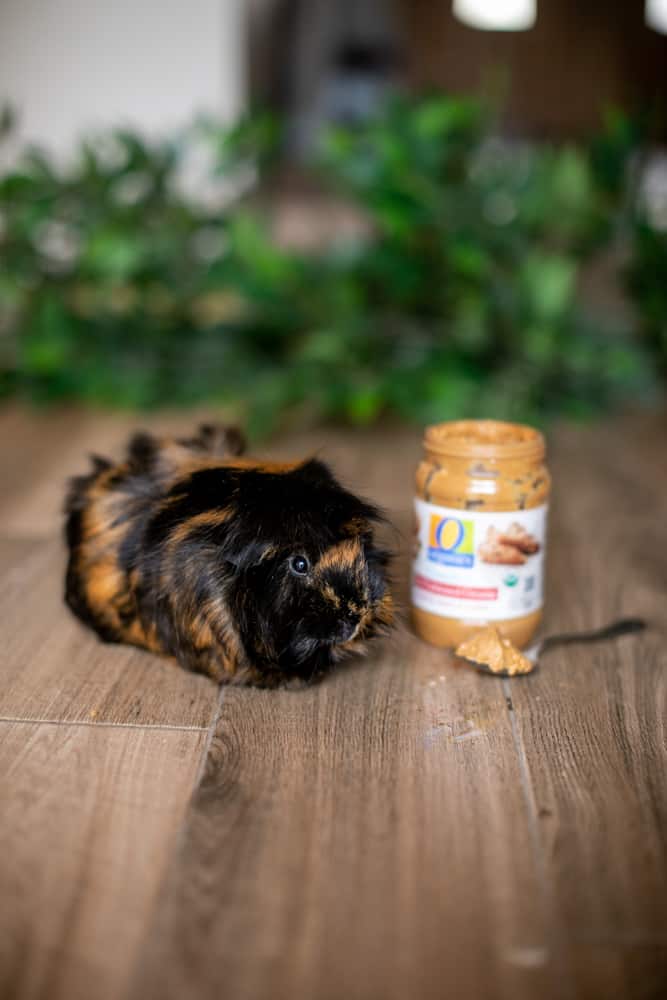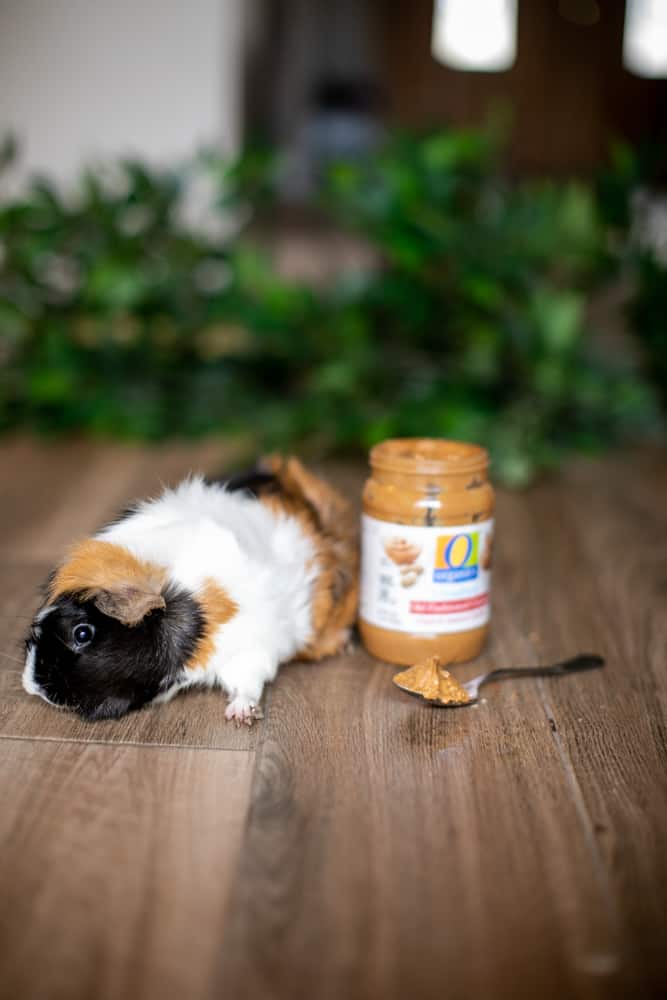As an Amazon Associate we earn from qualifying purchases.
Many people love the taste, and we can’t help but think if it is safe for animals to eat. In this article, we will dig deeper to know: can guinea pigs eat peanut butter?
Can A Guinea Pig Eat Peanut Butter?
Yes, you can feed peanut butter brands to your small pet. It is a high-fat food and should only be given in small amounts, but it is a healthy treat for your furry pet. Eating this is a good source of protein, vitamins B6 and E, niacin, and magnesium. It also has heart-healthy monounsaturated fats.

However, too much can cause weight gain, so it’s important to only give them a small amount as a treat.
Can Guinea Pigs Eat Peanuts?
Your small, furry pets are herbivores, so they typically eat a diet of hay, fresh vegetables, and pellets. However, some do enjoy snacking on ground dry roasted peanuts.
In small quantities, they are a healthy snack for them, but they should not make up the majority of their diet. It contains a few good health benefits and high levels of fat and acidic content, which can cause obese pets. A balanced diet is a key to keeping your pet healthy and happy!
Is Peanut Butter Safe For All Pets?
It is not particularly safe for all pets. Some dogs are allergic, and even if your dog doesn’t have an allergy, it is a choking hazard. It’s also too much fat and can cause obesity in pets. If you do choose to give them, only give them a small amount and make sure it does not have too much salt.
Possible Side Effects
When it comes to feeding this or any other human foods to your furry friend, there are some potential side effects that you should be aware of:
- For one, it can contain a lot of fat, and too much fat can cause weight gain in your pet.
- Additionally, it can also contain a lot of sugar, which can contribute to dental problems. If your pet eats a lot, they might end up with tooth decay and cavities.
- Some contain xylitol, an artificial sweetener that is toxic to pets. So before you give them, any type, be sure to check the ingredients list for xylitol.
- It can also potentially create problems with your pets’ digestive systems or lead to a painful and problematic bladder when fed too much.
Overall, It can be a healthy snack for them as long as it is given in moderation. And always be on the lookout for choking hazards! Your furry pet will love getting a little taste of this delicious spread.
So if you do choose to give them this spread, make sure to limit the amount you give them and monitor their weight and dental health regularly.

Guinea Pigs Diet
These small creatures are herbivores, so their healthy diet consists mainly of hay, fresh veggies, and a small number of pellets.
- Hay
Hay is essential because it helps keep their delicate digestive system functioning properly; they can’t process cellulose the way other animals do, so they need to eat hay to get the fiber they need.
There are many different types of hay available, so it’s important to choose one that is appropriate. For example, alfalfa hay is rich in calcium and is best suited for pregnant or nursing females.
Fresh timothy hay is lower in calcium and higher in fiber, making it a good choice for adult males and females.
- Fresh Vegetables
These are important because they provide important nutrients and vitamins.
A well-balanced diet is essential for keeping your guinea pig’s overall health, and leafy greens should be a key part of their diet.
Many different types of green leafy veggies are safe for them to eat, so it’s important to mix things up and provide them with a variety of different flavors.
- Carrots: These are rich in Vitamin A, which is essential for keeping your pet’s eyes healthy.
- Broccoli: This green vegetable is rich in fiber and Vitamin C, both of which are important for a pet’s health.
- Cabbage: This is a great source of Vitamin C and other nutrients.
- Zucchini: This is a low-calorie vegetable that is rich in water content, making it a good choice for overweight pets.
- Pellets
They should also eat a small number of pellets, which are specially made to meet their nutritional needs. Pellets should not make up the majority of their diet, but they do need them to get the right balance of nutrients.
There are many different types of pellets available, so it’s important to choose one that is appropriate for a pet’s age and stage of life. For example, young pets need a pellet that is rich in Vitamin C, while adults need one that is higher in fiber.
Pet Care

These furry friends make great pets for people of all ages. They are small, docile animals that are easy to care for and can be kept in a relatively small space. In this portion, we will discuss the basics of pet care, including diet, housing, and health.
- First and foremost, a guinea pig’s diet should be rich in fiber and low in sugar.
- When it comes to housing, they should have a large enough enclosure that they can move around in, but it does not need to be too large. Some people choose to keep their pets in a cage, while others allow them to roam free in an enclosed area. Whichever option you choose, be sure to provide your pet with plenty of toys and enrichment items to keep him occupied.
- They are generally healthy animals, but they can sometimes suffer from digestive problems such as diarrhea, hair loss, and respiratory infections.
- If you notice that your pet is not acting or looking normal, take him to the veterinarian for a check-up.
Final Thoughts
The spread is a great snack for furry friends and it is very healthy for them. They love the taste and it is best for their digestive system. It is important to make sure that it is unsalted and no sugary foods are allowed.
They can eat it every day, but it is best to give them a variety of different healthy food to keep them healthy. Thanks for giving your pet a delicious and healthy snack!